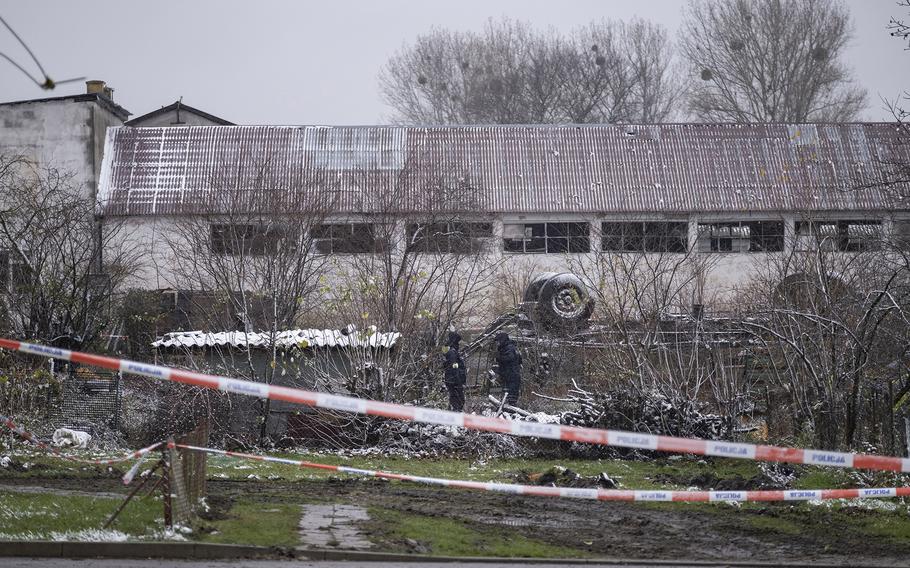
Police look for pieces of a missile at an explosion site in Przewodow, Poland, on Nov. 17, 2022. (Karolina Jonderko/The Washington Post)
KYIV, Ukraine — So many missiles were fired by Russia and Ukraine during the Russian attack on Ukrainian infrastructure Tuesday that the missile fragments that struck Poland could have been of either Russian or Ukrainian origin, Ukraine air force spokesman Yuriy Ignat said.
In an interview Friday, he described an intense battle during which at least 50 missiles were flying through the air within a matter of minutes near the Polish border in western Ukraine, with at least 20 fired by Russia and 30 fired by Ukrainian air defenses as Russia launched its biggest attack yet on Ukraine’s energy infrastructure. They were among a total of 96 missiles fired by Russia that day, 77 of which were shot down, he said.
“Anything could be the result of this air defense battle,” he said, acknowledging that at least some of the missile parts could have been Ukrainian.
His comments appeared to signal a further softening of Ukraine’s insistence that the missile parts that killed two Polish grain workers were not of Ukrainian origin, despite initial findings by investigators that they belonged to Ukrainian S-300 antiaircraft missiles. President Volodymyr Zelensky said earlier this week that he had “no doubt” the missiles were Russian but later said he couldn’t be “100 percent” sure the missiles weren’t Ukrainian.
Ukraine shot down 15 Russian missiles in the vicinity of the border region, but at least five more struck targets near the Polish border, meaning that Russia launched at least 20 missiles into the area, Ignat said. Ukraine’s air defenses typically fire at least two antiaircraft missiles at incoming ones, “so we can assume at least 30 missiles were launched from our side,” he said.
Ukrainian experts have now joined the Polish and American investigators who are looking into the causes of the explosion that killed two workers at a grain-drying facility in the Polish village of Przewodow, about four miles from the Ukrainian border, according to Ukrainian Foreign Minister Dmytro Kuleba. He thanked Poland on Twitter for granting access to the Ukrainian investigators.
Whether the missile parts that struck Poland were Ukrainian or Russian is irrelevant, Ignat said, because Russia bears ultimate responsibility for attacking Ukraine.
“Of course, it is necessary to investigate with Polish partners and put an end to this story, because to discuss one missile, which unfortunately killed people, is a great tragedy,” he said. “But everyone has forgotten that there were a hundred missiles in Ukraine.”
A smaller attack in which Russia fired around 15 more cruise missiles at Ukraine on Thursday added to the damage and also raised a mystery. Among them was a missile developed explicitly to carry nuclear warheads, a KH-55, according to the air force spokesman and the Ukrainian military’s Strategic Communications Center.
The nuclear warhead component of the missile had been removed, and it did not explode. There was no confirmed explanation for why the dud had been used, Ignat said.
One theory being floated is that Russia used the dud missile as a decoy, to confuse Ukrainian air defenses and increase the likelihood of one of the conventional missiles reaching their target, Ignat said. It could also mean that Moscow is running out of conventional precision missiles to use in the war, he and other officials said, or that the dud may have been a practice model that the Russians decided to use as a decoy.
A later variant of the KH-55, the KH-555, which was designed to carry a conventional warhead, has frequently been fired into Ukraine since the Russian invasion in February. And most of the conventional missiles that Russia has been using could be adapted for use with a nuclear warhead, meaning that Russia could carry out a nuclear strike on Ukraine without using missiles developed explicitly for nuclear purposes.
President Vladimir Putin’s comments in September that Russia was prepared to use “all available means” to win in Ukraine had triggered global alarm that he was contemplating nuclear strikes in an attempt to reverse Russian setbacks on the battlefield.
Those concerns had abated somewhat in recent weeks after U.S. officials said they had contacted to Russian officials to warn them of the consequences. Russia’s Foreign Ministry also issued remarks saying that nuclear weapons should never be used, and strong statements from China made it clear that Russia’s most powerful ally would not countenance a resort to nuclear strikes.
Meanwhile, 10 million people in Ukraine people are still without electricity after Tuesday’s attack, according to Zelensky. The damage compounded the impact of an earlier wave of strikes in October, and around half of Ukraine’s energy infrastructure is now out of action, Prime Minister Denys Shmyhal told reporters on Friday.
The capital, Kyiv, and the western city of Lviv, which until now had been relatively unscathed by the war, are among the most affected cities. Thursday brought the first snowfall of the season, and with temperatures expected to regularly drop below freezing for the next three months, Ukrainians are bracing for an icy winter without enough heating or light.
Ukrainian officials say Russia is targeting Ukrainian energy supplies to compensate for battlefield setbacks, including a retreat last week from the southern city of Kherson, the only major city captured by Russia since the February invasion.
The Washington Post’s Kostiantyn Khudov and David Stern in Kyiv contributed to this report.